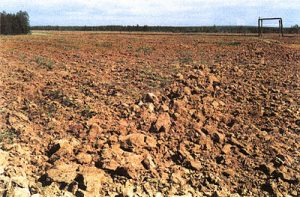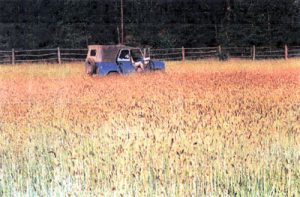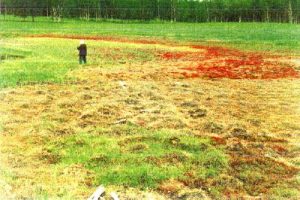Institute for Biological Problems of Cryolithozone, SB RAS, Yakutsk
Head of the Institute:
Boris I.Ivanov, Doctor of Agricultural Sciences, Professor
Principal researchers:
R.V.Desyatkin, Ph.D. (Biology)
L.G.Yelovskaya, Doctor of Agricultural Sciences, leading researcher
Project objectives
- Determine the main destabilising factors causing degradation of easily vulnerable frozen soils.
- Estimate the range and regional peculiarities of soil degradation of the cultivated (farming) zone of Yakutia.
Background and significance of objectives
Indicating a specific peculiarity of nature in Yakutia, Academician I.P.Gerasimov wrote: “… We deal here with pseudoequilibrium systems existing under the harshest (crucial) conditions and characterised by a very low ability to relaxation, i.e. to the acquisition of the so-called climax state. Moreover, it seems to me, one would better speak about ecological non-equilibrium relating to a considerable part of cryoxerogenic landscapes of northern Siberia in respect to even very insignificant anthropogenic effects. Their after-effects here, as a rule, are irreversible and destructive …” (Gerasimov, 1985, p. 175-176).
Soils are of great importance in regulating biogeocoenosis life. Soil composition and properties define not only their fertility but productivity, as well as the stability of all ground communities including agrocoenoses. Soils of the farming zone of Yakutia, like all other soils of the cryolithozone, have a low potential for fertility and resistance. There are reasons for that: small profile capacity, weak drainage, frozen waterproof horizon (the thermohydrogeochemical bar along the migration path); permafrost promoting the enhancement of soil water mineralisation and accumulation of pollutants; domination of recovering conditions in soils in respect to oxygen deficiency; a very weak biochemical and lowered chemical activity of soils (because of low temperatures) and a short period of biological soil “life” during the year.
The basic branch of agriculture in Yakutia is cattle breeding, farming is located in places of and developed in the central part of the republic. The state of agricultural lands in Yakutia is a concern. By 01.01.1998 the area of ploughed lands was as estimated 119.7 thousand ha, in comparison with 1996 the land area had reduced by 8.1 thousand ha, and with 1990 – by over 20 thousand ha. A decrease of cultivated land areas occurs owing to soil degradation including salination, an increase of alkalinity, water, wind and thermokarst erosion. Soils of the other agricultural lands are also in poor condition. Because of irrational use of pastures more than half of their areas has undergone pasture digression to different extent. Pasture soils may also be regarded as degrading. There is a tendency to a decrease of the productivity of mowing fields due to soil salinity rate (this process is spreading on nearly 40% of the hay field area).
At present the main mechanisms of genesis and geography of salinised soils of Yakutia have been studied. There is some knowledge about wind and water erosion in the region. The Permafrost Institute, SB RAS, has studied the regional mechanisms and thermokarst allocation more profoundly, the estimation of ground ice content and thermal risk of the Yakutian area has been carried out. The problems of frozen soils degradation under the agricultural development still remain insufficiently studied, especially when ploughed irrigated lands are exploited including pasture digression, the area of which is expanded every year.
Today it is especially urgent and of priority significance to determine all destabilising factors influencing the land resources of agricultural use under harsh bioclimatic conditions that are now in the crucial state and undergo degradation of readily vulnerable frozen soils, and also to evaluate the scale and regional features of soil degradation.
Research plan: approaches and methods
Investigation of the degrading soils state will be conducted using the techniques generally accepted in soil science, agrophysics and agrochemistry.
Expected results
- Characteristics of the mechanism and scale of soil degradation of cryoxerogenic landscapes of Yakutia will be provided.
- Development of the basis for the regional programme to fight with soil degradation of cryoxerogenic landscapes of Yakutia.
List of publications of participants related to the project
-
Desyatkin R.V. Soil formation in alases // Pochvovedeniye. – 1990. – ą 12. – P. 5-15 (In Russain).
-
Desyatkin R.V. Termokarst alas formation leads to synthetic salination // Pochvovedeniye. – 1992. ą 7. – P. 106-113 (In Russain).
-
Desyatkin R.V. On some ecological problems of agriculture in Yakutia // Problemy Ekologii Yakutii. Issue 1 Biogeograficheskiye issledovaniya. – Yakutsk, 1996. – P. 112-123 (In Russain).
-
Desyatkin R.V. Water balance disturbance following anthropogenic degradation of taiga-alas landscapes // Sibirsky Ekologicheskiy Zhurnal. – 1998. – ą 3-4. – P. 269-273 (In Russain).
-
Yelovskaya L.G. Salt dynamics in salinated soils of Central Yakutia // Trudy Konferetsii Pochvovedov Sibiri i Dalnego Vostoka. – Novosibirsk, 1964 (In Russain).
-
Yelovskaya L.G. Salinated soils of Yakutia // Pochvovedeniye. – 1965. – ą 4 (In Russain).
-
Yelovskaya L.G. Salt dynamics in salinated soils of meadow-chernozems of Central Yakutia // Issledovaniya Pochvennykh, Rastitelnykh i Faunisticheskikh Resursov Yakutii. – Yakuts: Publishing House, 1964 (In Russain).
-
Yelovskaya L.G. Genesis, regime and melioration of frozen salinated soils of Central Yakutia: Doctor of Agricultural Sciences’ Thesis, Moscow, 1967 (In Russain).
-
Yelovskaya L.G., Konorovky A.K., Savvinov D.D. Frozen salinated soils of Central Yakutia. – Moscow: Nauka Publishing House, 1966. – 274 p (In Russain).
-
Desyatkin R.V. Soil formation alases // Eurasian Soil Science. – 1991. – Vol. 23, ą 4. – P. 9-19.
-
Desyatkin R.V. Syngenetic soil salinization during alas development // Eurasian Soil Science. – 1993. – Vol. 25, ą 4. – P. 38-46.
-
Desyatkin R.V., Ibanov B.I., Ivanova A.D., Matsuura Y. Change of carbon content at the agricultural development of frozen soils // Proc. of the Symp. on Joint Permafrost Study between Japan and Russia in 1992-1994. – Yakutsk, 1995. – P. 36-39.
Fig. 1. Degraded frozen pale yellow soil on the ploughed field.
Fig. 2. Common foxtail meadow on the alas sod-meadow soil.
Fig. 3. Common foxtail meadow on the degraded alas sod-meadow soil.



